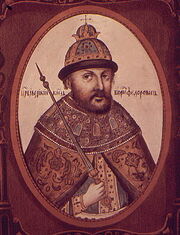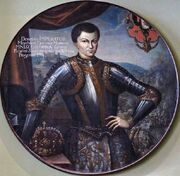Previous: the Cossacks
A. "The Time of Troubles"
A Marxist historian M. N. Pokrovsky thinks that "the Time of Troubles" in the history of Russia (end of XVI - beginning of XVII centuries, end of Rurik dynasty, start of Romanov dynasty) was a period of huge peasant rebellions, which in their scale were greater than the rebellions of Razin, Pugachev and Khemlnitsky (of XVII and XVIII centuries).

Ivan the Terrible, a painting by Vasnetsov, 1897
The roots of "the Time of Troubles" are in the reign of Ivan the Terrible (1530-1584), specifically in the period called "oprichnina". Wikipedia explains the term: "The term oprichnina... derives from the Russian word oprich (Russian: опричь, apart from, except)." Tsar Ivan the Terrible put himself apart from the rest of the Russian society (meaning the nobility) by picking out specific lands and regions, which were called to support the tsar and his separate army exclusively. Wikipedia continues: "The oprichnina
... is the period of Russian history between
Oprichniki kill a nobleman. To mock his alleged ambitions for the Tsar's throne, he was given the Tsar's regalia before execution.
Tsar Ivan the Terrible instituted a domestic policy of secret police, mass repressions, public executions, and confiscation of land from Russian aristocrats". In the process of this repression, lands have changed hands, as they were taken away from those whom the tsar suspected of disloyalty, and given to those whom the tsar thought to be loyal.
Ivan's murder of his own son (also named Ivan) left the throne effectively vacant. The throne passed to Boris Godunov, who was previously a regent to a weak-minded son of Ivan the Terrible named Fedor.

A "tsar's gun", made in 1586
It is important to note the times these people were living in. First, we see an introduction of artillery, as for example shown in the film of Sergey Eisenstein's "Ivan the Terrible", 1944. Also, in this period the merchants started obtaining power. For example, a Russian historian Kostomarov writes that in the reign of Boris Godunov there was no safety for the merchants. At any moment they could be seized and their money confiscated to the tsar's treasury. Hence, they tried not to show their wealth, and hence there was no stimuli for development of trade.

Ivan the Terrible killing his own son. A painting by Ilya Repin.
The period was one of beginning of development of merchant capital. Similar development was happening in England, France and other countries of Europe. Typical for this period is the struggle between the monarch and the feudal lords. The struggle culminates in victory of the monarch, and hence a short period of absolutism. For example, in England we see the reign of Elizabeth I; in France, the reign of Louis XIV. However, in Russia such struggle was complicated by the fact that the Rurik dynasty was cut short. In the reign of Boris Godunov, who followed Ivan the Terrible, there was a very poor harvest for a number of years, and hence millions of poor people - poor peasants - died from

Boris Godunov, an icon.
starvation. Godunov adopted the policy of re-introducing serfdom. The peasants were forbidden to switch from one landlord to another. They were "tied" to the land. As a result, the peasants ran away from their villages, en masse.
A peasant rebellion starts, nominally led by a man who called himself a

"False Dimitry", 1606
son of Ivan the Terrible, "Dimitry" (also known as "false Dimitry"). His army consists of the run-away peasants, the Cossacks, and Polish knights, desirous of plunder. Kostomarov writes that the strength of "Dimitry" was in support he obtained from common people in Russia, and in hatred which they felt towards the policies of Boris Godunov.
Boris Godunov was probably poisoned in Moscow and his army switched

Dimitry enters Moscow on June 20, 1605
sides. "Dimitry" entered Moscow in 1605. He tried to be not a "tsar", but a "father" to the people. Pokrovsky writes that bondage was greatly reduced. Previously, bondage (i.e. slavery because of a debt) was hereditary; but now it could last only up to the death of a person from whom money was borrowed. Laws on runaway peasants - a necessity to capture those who ran away from their landlords - were repealed. Dimitry freely conversed with craftsmen, often entering their workshops. He freely walked the streets and had a huge support among the Cossacks. Dimitry supported the printing, tried to create schools and a university in Moscow. He disliked the priests, whom he called "parasites" and started confiscating the property of monasteries.

Vasily Shuisky. He was the last in the line of the Rurik princes who ruled Russia.
The nobility and the church hated Dimitry. A conspiracy was created headed by one of the nobles, Vasily Shuisky. Shuisky spoke to the common people and told them that the tsar was in danger. The people started murdering the Polish knights, who came together with Dimitry to Moscow. Meanwhile, Shuisky and his company attacked the palace of Dimitry and killed him.
After the murder of Dimitry, there were speculations that he is alive. To prove the rumors wrong, Dimitry's body was dug out of the soil, and the bones were shot from a cannon "in the direction, which he came from". However, a second Dimitry appeared, who was supported by the Don Cossacks. He makes Tushino, a town 17 km from Moscow, his

Cossacks in Tushino in support of Dimitry.
headquarters. Monarchist historiography calls him "a Tushino thief", as he was a leader of "thieves", i.e. free Cossacks. For a few years, there was dual power in Russia, as there were two tsars: Vasily Shuisky, in Moscow, and false Dimitry II in Tushino.
The second Dimitry was defeated because there were divisions in his camp. Pokrovsky writes that gradually the entire staff of the Tushino army switched sides. They pledged allegiance to Minin, who was heading the army of the nobility. The Cossacks, together with a son of Dimitry II,

A monument to Minin and Pozharsky in Moscow.
run away to the Volga region. The army of nobility, now headed by Minin and Pozharsky, defeated the Polish knights, who locked themselves in the Moscow Kremlin.
The Cossack leaders and petty nobility, who formerly supported Dimitry, proposed the dynasty of Romanovs to be the new rulers of Russia. Romanovs were popular among the people, as Fyodor Romanov was one of the persons repressed by Boris Godunov, and he was a favorite of Dimitry I. Minin and Pozharsky, representing the large landlords and the merchants, were forced to accept this proposal, although they favored

The first of the Romanov dynasty, Mikhail. The last would be Nicholas II.
another dynasty. In 1613 a new tsar, Mikhail Romanov, 16 years old, was elected to the throne.
Initially, the nobility carefully observed the actions of Mikhail Romanov. When the nobility felt that the rule of the new dynasty suited their interests, i.e. the interests of the merchants, among whom the Romanovs were the first, they approved the son of Mikhail, Alexey, to be the next tsar.
To sum up: "oprichnina" was a cruel struggle between the tsar and nobility, typical for the period of transition to absolutist rule. Absolutist rule in Russia lasted only as long as Ivan the Terrible was alive. In "the Time of Troubles" we observe a declining authority of tsar (the weak-minded son of Ivan the Terrible), interregnum (the period of Boris Godunov), and Cossack-peasant rebellions. As a result, a new dynasty, representing the interests of the merchant class, has come to rule Russia for more than 300 years.
For a peasant-based rebellion to achieve a switch of dynasty was not a bad result. It is similar to peasant-based rebellions in China in XIX century. A new social system was not created, but a new dynasty came to represent the interests of a more progressive social class.